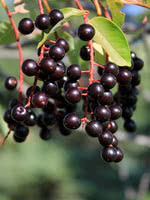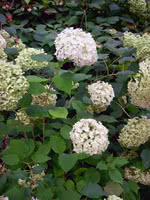Mon-Fri 9am - 5pm Mountain time
Western Chokecherry vs Annabelle Hydrangea
Prunus virginiana var. demissa
Hydrangea arborescens Annabelle
Western Chokecherry is a shrub or small tree commonly used for farmstead and field windbreaks.
It produces white flowers in the spring and edible dark purple fruit that matures between September and October. Its cherries are great for making for making jams, jellies or wine, but are not very palatable for raw eating.
Annabelle Hydrangea is a cold hardy shrub that is well known for its large, compact clusters of white flowers. Unlike other flowering species, Hydrangeas do best in partial shade. However, they are capable of growing in full sun if the soil is kept consistently moist.
Blooms occur on new wood, so regular pruning is encouraged in late winter. Try Annabelle Hydrangea as a border or on its own.
Western Chokecherry Quick Facts
Annabelle Hydrangea Quick Facts
Toxicity: toxic to horses, cattle, etc.)

